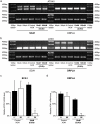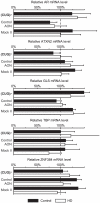Targeting several CAG expansion diseases by a single antisense oligonucleotide
- PMID: 21909428
- PMCID: PMC3164722
- DOI: 10.1371/journal.pone.0024308
Targeting several CAG expansion diseases by a single antisense oligonucleotide
Abstract
To date there are 9 known diseases caused by an expanded polyglutamine repeat, with the most prevalent being Huntington's disease. Huntington's disease is a progressive autosomal dominant neurodegenerative disorder for which currently no therapy is available. It is caused by a CAG repeat expansion in the HTT gene, which results in an expansion of a glutamine stretch at the N-terminal end of the huntingtin protein. This polyglutamine expansion plays a central role in the disease and results in the accumulation of cytoplasmic and nuclear aggregates. Here, we make use of modified 2'-O-methyl phosphorothioate (CUG)n triplet-repeat antisense oligonucleotides to effectively reduce mutant huntingtin transcript and protein levels in patient-derived Huntington's disease fibroblasts and lymphoblasts. The most effective antisense oligonucleotide, (CUG)(7), also reduced mutant ataxin-1 and ataxin-3 mRNA levels in spinocerebellar ataxia 1 and 3, respectively, and atrophin-1 in dentatorubral-pallidoluysian atrophy patient derived fibroblasts. This antisense oligonucleotide is not only a promising therapeutic tool to reduce mutant huntingtin levels in Huntington's disease but our results in spinocerebellar ataxia and dentatorubral-pallidoluysian atrophy cells suggest that this could also be applicable to other polyglutamine expansion disorders as well.
Conflict of interest statement
Figures








Similar articles
-
Ataxin-3 protein modification as a treatment strategy for spinocerebellar ataxia type 3: removal of the CAG containing exon.Neurobiol Dis. 2013 Oct;58:49-56. doi: 10.1016/j.nbd.2013.04.019. Epub 2013 May 6. Neurobiol Dis. 2013. PMID: 23659897
-
FAT10 protein binds to polyglutamine proteins and modulates their solubility.J Biol Chem. 2011 Aug 26;286(34):29594-600. doi: 10.1074/jbc.M111.261032. Epub 2011 Jul 8. J Biol Chem. 2011. PMID: 21757738 Free PMC article.
-
Amino acid sequences flanking polyglutamine stretches influence their potential for aggregate formation.Neuroreport. 2001 Oct 29;12(15):3357-64. doi: 10.1097/00001756-200110290-00042. Neuroreport. 2001. PMID: 11711886
-
Mini-review: spinocerebellar ataxias: an update of SCA genes.Recent Pat DNA Gene Seq. 2012 Aug;6(2):115-21. doi: 10.2174/187221512801327442. Recent Pat DNA Gene Seq. 2012. PMID: 22670601 Review.
-
Toward cell specificity in SCA1.Neuron. 2002 May 30;34(5):669-70. doi: 10.1016/s0896-6273(02)00715-8. Neuron. 2002. PMID: 12062012 Review.
Cited by
-
Mechanistic Insights and Potential Therapeutic Approaches in PolyQ Diseases via Autophagy.Biomedicines. 2023 Jan 9;11(1):162. doi: 10.3390/biomedicines11010162. Biomedicines. 2023. PMID: 36672670 Free PMC article. Review.
-
Suppression of Mutant Protein Expression in SCA3 and SCA1 Mice Using a CAG Repeat-Targeting Antisense Oligonucleotide.Mol Ther Nucleic Acids. 2019 Sep 6;17:601-614. doi: 10.1016/j.omtn.2019.07.004. Epub 2019 Jul 19. Mol Ther Nucleic Acids. 2019. PMID: 31394429 Free PMC article.
-
Molecular Strategies to Target Protein Aggregation in Huntington's Disease.Front Mol Biosci. 2021 Nov 12;8:769184. doi: 10.3389/fmolb.2021.769184. eCollection 2021. Front Mol Biosci. 2021. PMID: 34869596 Free PMC article. Review.
-
Structure of the myotonic dystrophy type 2 RNA and designed small molecules that reduce toxicity.ACS Chem Biol. 2014 Feb 21;9(2):538-550. doi: 10.1021/cb4007387. Epub 2013 Dec 16. ACS Chem Biol. 2014. PMID: 24341895 Free PMC article.
-
Self-duplexing CUG repeats selectively inhibit mutant huntingtin expression.Nucleic Acids Res. 2013 Dec;41(22):10426-37. doi: 10.1093/nar/gkt825. Epub 2013 Sep 13. Nucleic Acids Res. 2013. PMID: 24038471 Free PMC article.
References
-
- Cummings CJ, Zoghbi HY. Fourteen and counting: unraveling trinucleotide repeat diseases. Hum Mol Genet. 2000;9:909–916. - PubMed
-
- Nakamura K, Jeong SY, Uchihara T, Anno M, Nagashima K, et al. SCA17, a novel autosomal dominant cerebellar ataxia caused by an expanded polyglutamine in TATA-binding protein. Hum Mol Genet. 2001;10:1441–1448. - PubMed
-
- Bauer PO, Nukina N. The pathogenic mechanisms of polyglutamine diseases and current therapeutic strategies. J Neurochem. 2009;110:1737–1765. - PubMed
-
- Mcneil SM, Novelletto A, Srinidhi J, Barnes G, Kornbluth I, et al. Reduced penetrance of the Huntington's disease mutation. Hum Mol Genet. 1997;6:775–779. - PubMed
Publication types
MeSH terms
Substances
LinkOut - more resources
Full Text Sources
Other Literature Sources
Medical
Research Materials

